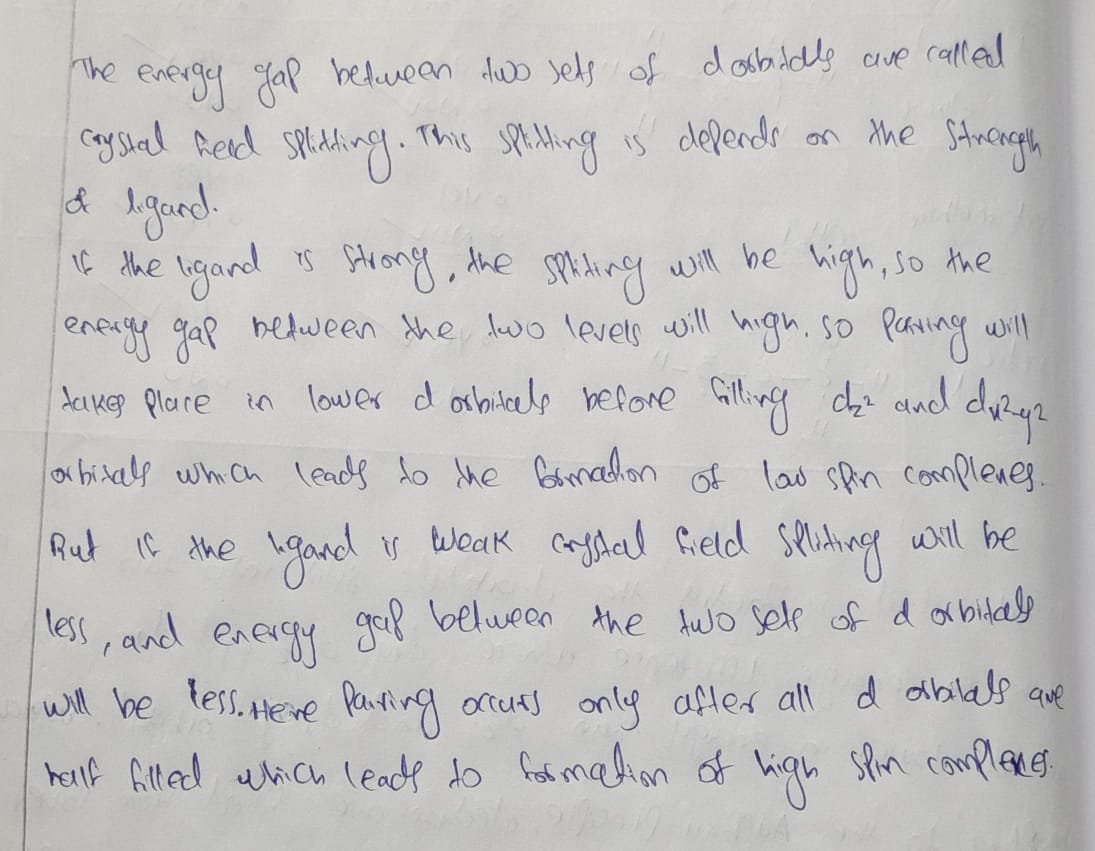The energies of the valence d orbitals on the iron atom in the octahedral (Note: the d orbitals are labeled with just their subscript, to make the labels easier to read.) Complete the diagram by adding the correct number of electrons to each orbital. 1 energy xy yz xz X | S [Fe(NH3)]* complex are split according to the electron box level diagram below. +
The energies of the valence d orbitals on the iron atom in the octahedral (Note: the d orbitals are labeled with just their subscript, to make the labels easier to read.) Complete the diagram by adding the correct number of electrons to each orbital. 1 energy xy yz xz X | S [Fe(NH3)]* complex are split according to the electron box level diagram below. +
Chemistry
10th Edition
ISBN:9781305957404
Author:Steven S. Zumdahl, Susan A. Zumdahl, Donald J. DeCoste
Publisher:Steven S. Zumdahl, Susan A. Zumdahl, Donald J. DeCoste
Chapter1: Chemical Foundations
Section: Chapter Questions
Problem 1RQ: Define and explain the differences between the following terms. a. law and theory b. theory and...
Related questions
Question
![The energies of the valence d orbitals on the iron atom in the octahedral \([ \text{Fe(NH}_3\text{)}_6 ]^{2+}\) complex are split according to the electron box level diagram below.
(Note: the d orbitals are labeled with just their subscript, to make the labels easier to read.)
Complete the diagram by adding the correct number of electrons to each orbital.
**Diagram Explanation:**
- The diagram is divided into two levels representing different energy states of the d orbitals in an octahedral crystal field.
- The vertical axis is labeled as "energy" and represents increasing energy as you move upwards.
- The top level has boxes labeled \(d_{z^2}\) and \(d_{x^2-y^2}\), indicating these orbitals have higher energy.
- The bottom level has boxes labeled \(d_{xy}\), \(d_{yz}\), and \(d_{xz}\), indicating these orbitals have lower energy.
- There is also a section on the right with buttons labeled "1", a down arrow, and an eraser, along with "×" and a curved arrow, suggesting tools for adding, removing, or resetting electrons in the diagram.](/v2/_next/image?url=https%3A%2F%2Fcontent.bartleby.com%2Fqna-images%2Fquestion%2Fd11077d3-f0b7-424b-830f-d72f05e11bec%2F57bf4a23-2dde-4c11-aa47-df55d3f1369f%2Fobocb46_processed.jpeg&w=3840&q=75)
Transcribed Image Text:The energies of the valence d orbitals on the iron atom in the octahedral \([ \text{Fe(NH}_3\text{)}_6 ]^{2+}\) complex are split according to the electron box level diagram below.
(Note: the d orbitals are labeled with just their subscript, to make the labels easier to read.)
Complete the diagram by adding the correct number of electrons to each orbital.
**Diagram Explanation:**
- The diagram is divided into two levels representing different energy states of the d orbitals in an octahedral crystal field.
- The vertical axis is labeled as "energy" and represents increasing energy as you move upwards.
- The top level has boxes labeled \(d_{z^2}\) and \(d_{x^2-y^2}\), indicating these orbitals have higher energy.
- The bottom level has boxes labeled \(d_{xy}\), \(d_{yz}\), and \(d_{xz}\), indicating these orbitals have lower energy.
- There is also a section on the right with buttons labeled "1", a down arrow, and an eraser, along with "×" and a curved arrow, suggesting tools for adding, removing, or resetting electrons in the diagram.
Expert Solution
Step 1: Filling of electrons in d orbitals of Octahdral complexes
 l
l
Step by step
Solved in 3 steps with 4 images

Knowledge Booster
Learn more about
Need a deep-dive on the concept behind this application? Look no further. Learn more about this topic, chemistry and related others by exploring similar questions and additional content below.Recommended textbooks for you

Chemistry
Chemistry
ISBN:
9781305957404
Author:
Steven S. Zumdahl, Susan A. Zumdahl, Donald J. DeCoste
Publisher:
Cengage Learning

Chemistry
Chemistry
ISBN:
9781259911156
Author:
Raymond Chang Dr., Jason Overby Professor
Publisher:
McGraw-Hill Education

Principles of Instrumental Analysis
Chemistry
ISBN:
9781305577213
Author:
Douglas A. Skoog, F. James Holler, Stanley R. Crouch
Publisher:
Cengage Learning

Chemistry
Chemistry
ISBN:
9781305957404
Author:
Steven S. Zumdahl, Susan A. Zumdahl, Donald J. DeCoste
Publisher:
Cengage Learning

Chemistry
Chemistry
ISBN:
9781259911156
Author:
Raymond Chang Dr., Jason Overby Professor
Publisher:
McGraw-Hill Education

Principles of Instrumental Analysis
Chemistry
ISBN:
9781305577213
Author:
Douglas A. Skoog, F. James Holler, Stanley R. Crouch
Publisher:
Cengage Learning

Organic Chemistry
Chemistry
ISBN:
9780078021558
Author:
Janice Gorzynski Smith Dr.
Publisher:
McGraw-Hill Education

Chemistry: Principles and Reactions
Chemistry
ISBN:
9781305079373
Author:
William L. Masterton, Cecile N. Hurley
Publisher:
Cengage Learning

Elementary Principles of Chemical Processes, Bind…
Chemistry
ISBN:
9781118431221
Author:
Richard M. Felder, Ronald W. Rousseau, Lisa G. Bullard
Publisher:
WILEY